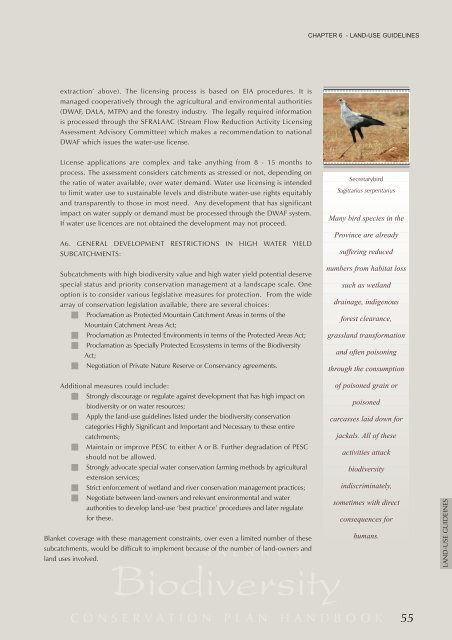Mpumalanga Biodiversity Conservation Plan Handbook - bgis-sanbi
Mpumalanga Biodiversity Conservation Plan Handbook - bgis-sanbi
Mpumalanga Biodiversity Conservation Plan Handbook - bgis-sanbi
You also want an ePaper? Increase the reach of your titles
YUMPU automatically turns print PDFs into web optimized ePapers that Google loves.
extraction’ above). The licensing process is based on EIA procedures. It is<br />
managed cooperatively through the agricultural and environmental authorities<br />
(DWAF, DALA, MTPA) and the forestry industry. The legally required information<br />
is processed through the SFRALAAC (Stream Flow Reduction Activity Licensing<br />
Assessment Advisory Committee) which makes a recommendation to national<br />
DWAF which issues the water-use license.<br />
License applications are complex and take anything from 8 - 15 months to<br />
process. The assessment considers catchments as stressed or not, depending on<br />
the ratio of water available, over water demand. Water use licensing is intended<br />
to limit water use to sustainable levels and distribute water-use rights equitably<br />
and transparently to those in most need. Any development that has significant<br />
impact on water supply or demand must be processed through the DWAF system.<br />
If water use licences are not obtained the development may not proceed.<br />
A6. GENERAL DEVELOPMENT RESTRICTIONS IN HIGH WATER YIELD<br />
SUBCATCHMENTS:<br />
Subcatchments with high biodiversity value and high water yield potential deserve<br />
special status and priority conservation management at a landscape scale. One<br />
option is to consider various legislative measures for protection. From the wide<br />
array of conservation legislation available, there are several choices:<br />
Proclamation as Protected Mountain Catchment Areas in terms of the<br />
Mountain Catchment Areas Act;<br />
Proclamation as Protected Environments in terms of the Protected Areas Act;<br />
Proclamation as Specially Protected Ecosystems in terms of the <strong>Biodiversity</strong><br />
Act;<br />
Negotiation of Private Nature Reserve or Conservancy agreements.<br />
Additional measures could include:<br />
Strongly discourage or regulate against development that has high impact on<br />
biodiversity or on water resources;<br />
Apply the land-use guidelines listed under the biodiversity conservation<br />
categories Highly Significant and Important and Necessary to these entire<br />
catchments;<br />
Maintain or improve PESC to either A or B. Further degradation of PESC<br />
should not be allowed.<br />
Strongly advocate special water conservation farming methods by agricultural<br />
extension services;<br />
Strict enforcement of wetland and river conservation management practices;<br />
Negotiate between land-owners and relevant environmental and water<br />
authorities to develop land-use ‘best practice’ procedures and later regulate<br />
for these.<br />
Blanket coverage with these management constraints, over even a limited number of these<br />
M P U M A L A N G A<br />
subcatchments, would be difficult to implement because of the number of land-owners and<br />
<strong>Biodiversity</strong><br />
land uses involved.<br />
CHAPTER 6 - LAND-USE GUIDELINES<br />
Secretarybird<br />
Sagittarius serpentarius<br />
Many bird species in the<br />
Province are already<br />
suffering reduced<br />
numbers from habitat loss<br />
such as wetland<br />
drainage, indigenous<br />
forest clearance,<br />
grassland transformation<br />
and often poisoning<br />
through the consumption<br />
of poisoned grain or<br />
poisoned<br />
carcasses laid down for<br />
jackals. All of these<br />
activities attack<br />
biodiversity<br />
indiscriminately,<br />
sometimes with direct<br />
consequences for<br />
humans.<br />
CONSERVATION PLAN HANDBOOK<br />
55<br />
LAND-USE GUIDEINES

















